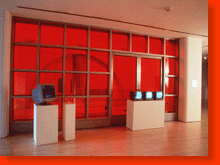

Not to See a Thing-Joel Slayton 1997-98 San Jose Museum of Art in collaboration with the Whitney Museum of American Art
The acrylic cube is surveilled using 3 accurately positioned outdoor BW video cameras to convey x,y,z viewing planes constituting a Cartesian perspective. Telematic views of the substitute are presented in the exhibition gallery on separate surveillance monitors. Atmospheric conditions in the outdoor sculpture court, directly affecting the substitute are continuously monitored.
Located in the installation space are two Silicon Graphic 02 workstations. The first workstation presents a 3D virtual rendition of the substitute sculpture. Texture mapped


